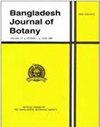孟加拉国番茄无土栽培技术孟加拉国番茄无土栽培技术
IF 0.3
4区 生物学
Q4 PLANT SCIENCES
引用次数: 0
摘要
这项研究旨在开发一种高效、可重复的方法,以克服孟加拉国的干旱压力和日益严重的农田危机。Banglaponics 是一种无土栽培技术,由池塘水中的传统农肥和牛尿混合而成,用于评估番茄生产的效率。Banglaponics 培养基的番茄产量(237.85 ± 10.87 克/株)显著高于土壤培养基(p < 0.05)。所研究植株的株高、叶片数、叶面积、根数、根长和花朵数在 Banglaponics 培养基中明显高于土壤培养基中的植株(p < 0.05)。两种处理的叶绿素得分和抗氧化活性(DPPH)几乎相同。尽管孟加拉国鱼菜共生培养基中的钙含量较低,但其叶片中铁和锌的含量却高于土壤中的含量。此外,孟加拉国皂化种植的植物的铅含量也明显低于土壤种植的植物。相反,其他两种重金属铬和镉的含量几乎相同。从外观上看,孟加拉国皂素种植的植物要比土壤种植的植物健康得多。这种技术可以在孟加拉国的干旱地区推广,因为它比土壤种植的番茄需要的水要少得多。孟加拉国植物学杂志52(4):933-939,2023 年(12 月)本文章由计算机程序翻译,如有差异,请以英文原文为准。
Banglaponics: A Soilless Cultivation Technique For Tomato In Bangladesh
The study was carried out to develop an efficient, reproducible method to overcome the drought stress and increasing agriculture field crisis of Bangladesh. Banglaponics, a soilless cultivation technique comprised of traditional agricultural fertilizers in pond water mixed with cow urine has been used to evaluate the efficiency of tomato production. The production rate (237.85 ± 10.87 g/plant) was significantly (p < 0.05) higher in the Banglaponics medium than soil medium. Plant height, leaf number, leaf area, root number, root length, and flower number of the studied plant showed significantly (p < 0.05) higher in Banglaponics medium than plants grown in soil. Both treatments showed that chlorophyll score and antioxidant activity (DPPH) were almost equal. Banglaponically grown plant leaf, despite having lower Ca concentrations, possessed higher concentrations of Fe and Zn than those of soil-grown. Additionally, Banglaponically grown plant also showed significantly much lower Pb concentrations than that of grown in soil. On the contrary the other two heavy metals Cr and Cd, hold nearly the same value. By appearance, Banglaponically-grown plants were much healthier than that of soil-grown. This technique can be introduced in drought-prone areas of Bangladesh as it requires much less water than soil-grown tomato plants. Bangladesh J. Bot. 52(4): 933-939, 2023 (December)
求助全文
通过发布文献求助,成功后即可免费获取论文全文。
去求助
来源期刊

Bangladesh Journal of Botany
生物-植物科学
CiteScore
0.80
自引率
0.00%
发文量
77
审稿时长
9 months
期刊介绍:
Bangladesh in situated on the north of Bay of Bengal. Climatically it is a humid subtropical country. Most of the land is deltaic plain of two great rivers, the Ganges and the Bhrammaputra and it tributaries. The country has rich diversity of plants. Main crops cultivated are Rice, Jute, Wheat, Maize, Sugarcane, Mustard and different kinds of Lentils. There are a good number of Public and Private Universities and Plant Research Establishments.
Bangladesh Journal of Botany is the official organ of the Bangladesh Botanical Society established in 1972. Since 1972 Bangladesh Journal of Botany is being published regularly. Two issues of the Journal are published, one in June and another in December.
Scientific papers (Full paper and short communication) on any field of Plant Sciences from anywhere in the World are considered for publication in Bangladesh Journal of Botany.
 求助内容:
求助内容: 应助结果提醒方式:
应助结果提醒方式:


